Emotional intelligence (EQ) plays an integral role in human interaction. Emotional intelligence is the ability to control your emotions based on the environment, interaction, and desired response.
A mental health therapist improves your ability to recognize and understand your own emotions– Click the button below to schedule your appointment.
Generally, humans possess a remarkable ability to control their emotions in most situations. For example, it’s common to laugh when you’re happy and cry when sad or angry.
However, for some people, emotional control is a difficult aspect to understand or actualize effectively.
You could have emotional lability when you cannot voluntarily match your emotions to the situation or what you’re feeling.
Emotional lability is common in people with a history of mental disorders like attention deficit hyperactivity disorder (ADHD) and bipolar disorder.
Because of how disruptive emotional lability can get, it could significantly affect your daily functioning and ability to create strong and meaningful relationships.
Read on to learn more about emotional lability, its causes and diagnosis, and most importantly, the available treatment options. You’ll also learn what to do if you exhibit emotional lability or know someone who does.
1. What Is Emotional Lability?
Emotional lability is a disorder that exhibits itself as uncontrollable emotions and moods that are often rapid and extreme.
For example, someone with the condition may experience bouts of uncontrollable crying, joy, laughter, and a range of other emotions with no logical explanation.
In most cases, these rapid emotions are out of context and do not necessarily depict what the person is feeling or their emotional state.
Emotional lability is identified by numerous names, including:
- Emotionalism
- Affective liability
- Emotional incontinence
- Involuntary emotional expression disorder
- Pathological laughing and crying or pseudobulbar affect (PBA)
PBA refers to mood liability caused by brain injury or certain neurological disorders.
It’s important to understand that at some point, everyone experiences distorted moods. However, this is not usually common, and your mood and expression usually match what you’re feeling.
With emotional lability, you have little to no control over your moods. Even when you’re happy or joyful, you could still end up crying or displaying emotions related to anger.
Emotional lability can also lead you to display overly expressive emotions in situations and environments where you normally wouldn’t. For instance, you may begin crying uncontrollably when at the library for no apparent reason.
These emotions are often embarrassing, confusing and can interfere with your relationships and ability to connect with others.
2. What Are the Symptoms of Emotional Lability?
As mentioned above, everyone experiences dissociative moods at some point. Factors like stress and mood swings could lead to unusual emotional reactions. As a result, having mood swings or mismatched emotions alone is not indicative of emotional lability.
Some of the other common symptoms associated with emotional lability include:
- Brief but frequent emotional outbursts
- Mixed emotional outbursts, i.e. laughter turning into tears
- Reduced emotional response and symptoms between episodes
- Laughing or crying in situations that don’t match the feeling or reaction
- Excess and intense emotional responses in mundane situations
- Emotional outbursts that don’t match your character or personality
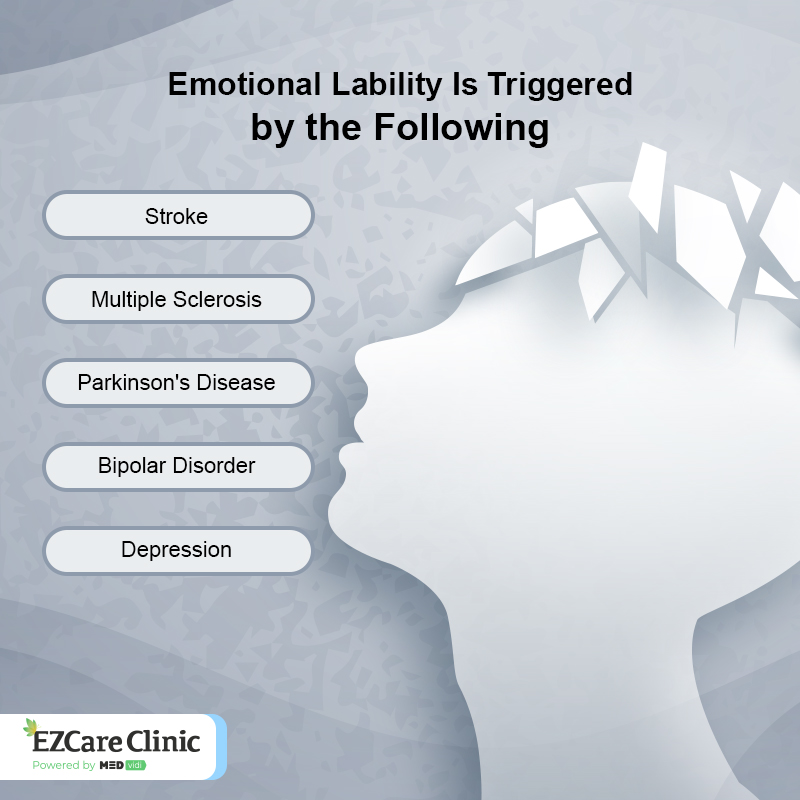
Conditions Associated With Emotional Lability
How Different Is Emotional Lability from Mood Swings?
Mood swings are like a roller coaster and cause a sudden shift in your mood. For example, you could be happy one minute and sad the next. You’ve likely experienced mood swings several times in your life.
Mood swings often have an associative trigger.
For instance, if you’re afraid of clowns and are having fun at a carnival, your mood could quickly shift when you see a clown. However, this feeling will disappear with time.
Unlike moods swings, the effects of emotional lability can last from a few hours to days or even longer.
Moreover, there may be no clear cause that triggers the mood shift. So, if you’re at the carnival, your mood could shift even without seeing or thinking of a clown.
By controlling your triggers, you can overcome mood swings and take control of your feelings. However, with emotional lability, you have little-to-no control over the mood you display.
3. How Is Emotional Lability Diagnosed?
Emotional lability is diagnosed under the stipulations outlined in the International Classification of Diseases.
The International Classification of Diseases (ICD) is a globally recognized diagnostic tool used for:
- Epidemiology
- Health management
- Clinical purposes
The ICD also maintains relevant information on health analyses like mortality and morbidity trends. Information relating to emotional lability is housed under code R45.86 of the ICD.
A mental health therapist paves a way to treat people with a mental disorder by helping them understand their illness- Click below to schedule your appointment.
In most occasions, emotional lability gets undiagnosed, underdiagnosed, or completely misdiagnosed as a form of mood disorder, especially depression.
This is especially true in cases where crying is one of the prominent emotions expressed.
While patients suffering from emotional lability could also have depression, the crying episodes for emotional lability are more pronounced, brief, and are independent with general sadness.
Aside from the above-mentioned symptoms of emotional lability, doctors formally diagnose the condition after exhaustive neurological evaluations.
These evaluations are tailored to detect potential deficits and abnormalities in the brain structure and function that can help with the effective diagnosis of emotional lability of
For emotional lability or pseudobulbar affect to be correctly diagnosed, a patent must undergo a diagnostic checklist that seeks to investigate factors like:
- Is the emotional response occurring involuntarily, suddenly, and without the subject’s control?
- Is the emotional response inconsistent with the subject’s mood and feelings?
- Does expressing the emotion result in relief for the subject?
- Does the emotional response result in significant distress or limit the subject’s inability to work or interact with others?
- Do other psychiatric and neurological disorders cause the same response?
- Could the dynamic response be the result of a drug?
1. Emotional Lability Questionnaire
Doctors also use standardized tests and questionnaires to diagnose emotional lability and pseudobulbar affect. A high score on these tests indicates you could have emotional lability.
Some of the standardized tests employed by doctors to diagnose the condition include:
- The Pathological Laughter and Crying Scale (PLACS)
This test consists of 18 questions which are assessed by a trained health professional. You are graded on each question on a scale of zero to three, with zero being the average and three showing signs of emotional lability.
The PLACS test examines various elements of PBA, including the length, severity, and progression of the condition. Generally, if you score 13 or higher on PLACS, you could likely have emotional lability.
- The Center for Neurologic Study-Liability Scale (CNS-LS)
CNS-LS is a self-administered test used to diagnose emotional lability. The test consists of seven questions that you can complete on your own.
CNS-LS tests measure the quantitative frequency of PBA episodes, and a score of 13 or higher can indicate emotional lability.
- Positive and Negative Affect Schedule (PANAS)
PANAS is a comprehensive test used to assess general positive and effective emotions. This test assesses your feelings from one week to another and how they affect your everyday interaction with others and the world.
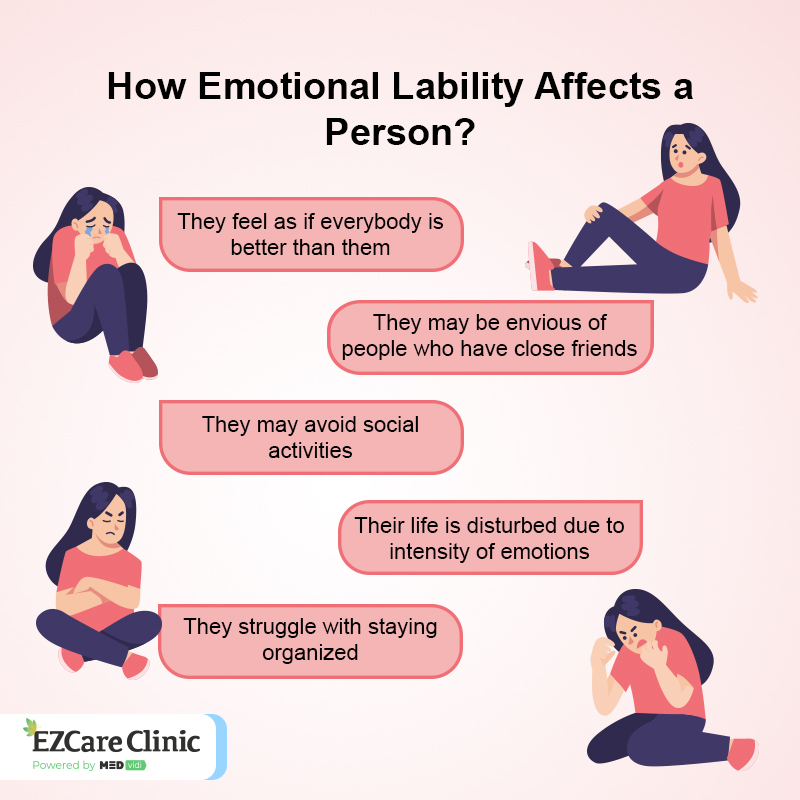
Impacts of Emotional Lability on a Person
2. Misdiagnosis of Emotional Lability
Emotional lability is a commonly misdiagnosed condition as its associative symptoms are common with other commonly diagnosed mental disorders.
However, it’s vital to understand it’s possible to have emotional lability even when some of the symptoms point to other conditions.
As with any condition, the effectiveness of treatment and management procedures is dependent on correct diagnosis.
That’s why it’s important to discuss with your doctor the underlying cause of why you may be exhibiting emotional lability symptoms.
Some of the conditions that are often diagnosed in place of PBA include:
- Euphoria
This is excessive laughter and joy, which is sometimes associated with conditions like multiple sclerosis (MS).
- Bipolar disorder
This condition is highly linked to mood swings.
- Post-traumatic Stress Disorder
PTSD is mostly caused by a past traumatic event, although it can also result from conditions leading to traumatic brain injuries (TBI).
- Depression
Being depressed has a profound effect on your emotions, feelings, and overall actions.
Click the banner below to schedule your appointment with a mental health professional.
4. Emotional Lability Causes and the Associative Physiology of Emotions
The exact cause of emotional lability is yet to be fully understood. However, the condition is almost always linked to neurological conditions that result in brain damage or injury.
Factors like fatigue, anxiety, and stress, overstimulated senses like loud noises and large crowds, and being around people who display strong emotions can also contribute to the development of emotional lability.
Other contributing factors include extreme emotions, the loss of a loved one, and situations that cause stress and strong emotions.
Here’s more information on the known and underlined causes and physiology of emotions linked to emotional lability. The major causes that correlate with emotional lability include:
1. Brain Injury
Damage to the brain can significantly alter its normal functioning.
Depending on the severity of the damage, you notice differences in emotional awareness and sensitivity, both towards yourself and others.
The result of this experience could lead you to respond inappropriately to certain people, events, or environments.
For instance, you may have trouble relating to specific topics, emotional movies, or even stories by your friends. Weakened emotional control, coupled with low tolerance, stress, and weariness, can result in dramatic shifts in responding to things in an emotional capacity.
2. Mental Illnesses
Various mental conditions that affect your moods or have symptoms directly tied to your emotions can cause emotional lability.
A mental health therapist treats the rigid and unhealthy thinking patterns involved in a mental illness– Click the button below to schedule your appointment.
Some of these conditions and associative symptoms include:
- Borderline Personality Disorder (BPD)
This is a mental condition that involves patterns of:
-
- Frequent mood swings
- Impulsivity
- Inability to maintain healthy relationships
- Self-image disturbance
- Bipolar Disorder
This is a mental illness associated with symptoms like:
-
- Unusual and quick mood changes
- Inactiveness
- Fluctuating levels of energy
- Inability to perform previously easy daily tasks
- Dementia
This condition is well known for the progressive decline in cognitive function and overall memory dissonance.
- Stroke
Strokes can affect different parts of the brain, which can interfere with cognitive function in various ways.
The affected areas and extent of damage can lead to very different conditions. After suffering from a stroke, patients often experience noticeable behavioral and emotional changes.
And since stokes directly impact the brain’s normal functioning, they can greatly disrupt its ability to control emotions and lead to emotional lability.
- Epilepsy
This is a neurological disorder that stems from electrical disturbances and irregularities in the brain.
Epilepsy can lead to seizures, which can then result in abnormal movement, behavior, and experiences. This neurological disorder has also been linked to reduced emotional awareness and consciousness.
3. Traumatic Brain Injuries (TBI)
Several injuries can affect the brain and lead to emotional lability.
Some of the common types of TBIs include:
-
- Skull fractures
- Penetrative injuries
- Coup-countercoup injuries
- Oxygen deprivation
- Lacerations
- Blunt force head trauma
4. Emotional Lability During Pregnancy
Pregnancies are directly tied to your mental wellbeing and can lead to significant psychological changes.
Pregnant women stand the risk of developing mental health issues, especially during the perinatal pregnancy stages. Women often report emotional fluctuations and dissonance throughout the term of the pregnancy.
For example, many women experience reduced negative emotions during the second trimester, compared to the first and third trimesters.
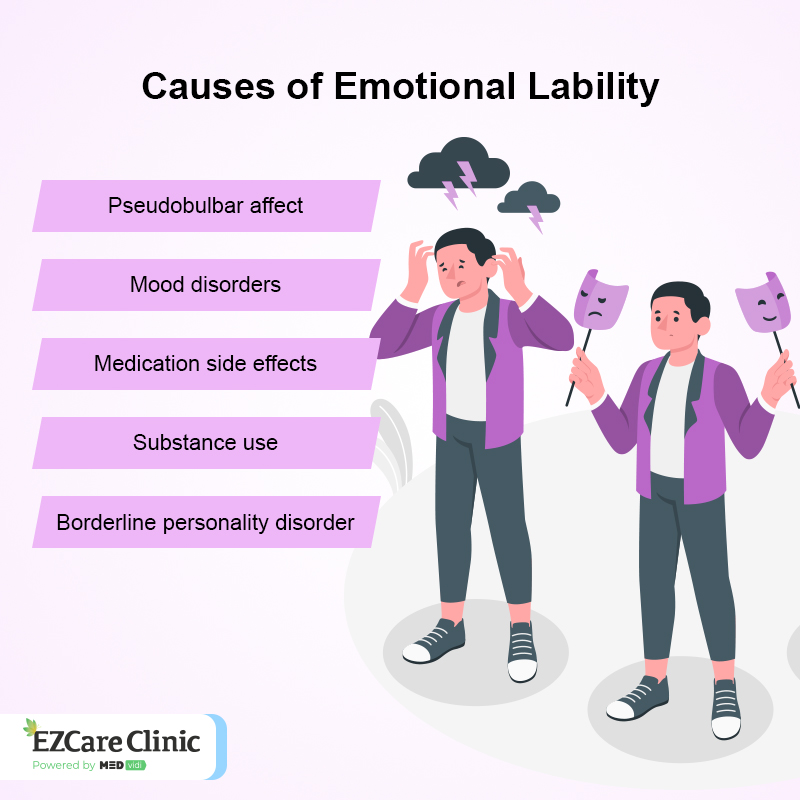
Emotional Lability Causes
What Part of the Brain Controls Emotions?
The human brain is arguably the most complex structure known to man. Your brain function and cognitive ability are a major part of what differentiates man from almost every other creature.
Humans can control, modify, and manipulate emotional experiences through an intricate range of skills and in an immensely complex manner.
This virtually limitless brain potential has puzzled scientists for ages, leading to the question, how exactly does the brain develop emotion?
A conclusive answer to this question remains a mystery.
However, it is now known that the limbic system is largely responsible for human emotional and behavioral responses. The limbic system is a collection of intricately woven structures deep within the brain.
Scientists and brain experts are yet to agree on a definitive list of the structures that make up this intricate system.
There are, however, various structures that have been identified as part of the limbic system and play an integral role in emotional and behavioral responses.
These structures include:
1. Hypothalamus
The hypothalamus plays a key role in controlling your emotional responses.
Additionally, this part of the brain is also responsible for regulating:
-
- Body temperature
- Hormone release
- Sexual response
2. Hippocampus
The hippocampus’s main role is preserving and retrieving memories. It is also responsible for helping you understand perceptual dimensions in your environment.
3. Amygdala
The amygdala is responsible for coordinating a response to the things in your environment, especially the ones that trigger an emotional response. Additionally, the amygdala plays an integral role in your anger and fear responses.
4. Limbic Cortex
The limbic cortex comprises the parahippocampal gyrus and the cingulate gyrus, which play a role in motivating you, judgments, and overall mood.
Here’s a table to show a simple representation of the part of the brain responsible for controlling various emotions.
| Parts of the Brain | Emotions Controlled |
| Stimulation of the amygdala, followed by the hypothalamus | Fear |
| Amygdala stimulating the hypothalamus | Anger |
| Limbic cortex and precuneus | Happiness |
| Hypothalamus triggers the release of other hormones like dopamine, oxytocin, and vasopressin. | Love |
5. What Is the Relationship Between Stroke and Emotional Lability?
After suffering from a stroke, it is normal to experience hard to control or understand some emotions. Most of these changes result from actual injury to the brain, while others are caused by chemical changes that happen after a stroke.
These emotional changes will disappear with time, and you’ll gradually get back to the previous state.
Prolonged emotional and personality changes can prove difficult to cope with, both for patients and their families.
Some of the changes you might see after having a stroke include:
- A general change in your mood and personality
- Crying or laughing with no apparent reason or cause
- Behavioral and personality changes that often get better with time
How Does Stroke Cause Emotional Changes?
Strokes affect the brain both directly and indirectly. As mentioned above, the changes result from physical damage to the brain and chemical changes that occur after the attack.
Some of the emotional changes exhibited after a stroke result from fear and frustrations you feel as you try to accept the stroke happened and deal with the aftereffects.
In such cases, talking about the stroke and how it affected you can help alleviate most of these emotional changes.
When the stroke happens on the right side of the brain, emotional changes are more pronounced.
This is because the brain faculties responsible for your emotions are on the right side of the brain. Both the frontal lobe and limbic system are found on the right side and play an integral role in your emotions.
Mental health therapy is a way to help people with emotional difficulties such as anger or fear- Click below to schedule your appointment.
When the brain’s emotional center is affected by a stroke, it can lead to pseudobulbar affect (PBA), leading to uncontrollable emotional outbursts.
PBA is also common in patients who suffer from a brainstem stroke. In case you start experiencing moods that don’t match the situation you’re in, it may be a warning sign of emotional lability.
If you experience this, you should consult with your doctor or therapist for a professional review.
Some of the common emotional changes you might experience after suffering from a stroke include:
-
- Rapid mood changes – like starting to cry for no apparent reason
- Laughing and crying without a clear reason
- Crying and laughing longer than you normally would before the stroke
- Anxiety and uneasiness
- Frustration
- Sadness and depression
- Apathy and disregard for whatever happens
6. What Is the Difference Between Emotional Lability and Borderline Personality Disorder?
Borderline personality disorder (BPD) is one of the mental conditions commonly confused with emotional lability. There are numerous cases of patients with either condition who got diagnosed for the other.
Emotional dysregulation (ED) is one of the primary contributing factors that lead to borderline personality. ED consists of troubles regulating your emotions, leading to the inability to behave effectively or pursue essential life goals.
Because of the effects of emotional dysregulation, borderline personality disorder sometimes also known as an emotionally unstable personality disorder (EUPD), is one of the extensively studied personality disorders.
Current understanding depicts borderline personality with:
- Anxiety
- Emotional lability
- Separation insecurity
- Depression
- Impulsiveness
- Risk exposure
Other traits of the personality disorder include:
- Hostility
- Antagonism
- Negative affectivity
Here’s more information on borderline personality disorders.
What Is a Borderline Personality Disorder?
Borderline personality disorder (BPD) is a mental health condition that affects your feelings towards yourself and others.
The impact of borderline personality disorder can be felt in everyday scenarios and can hamper effective relationships.
The disorder has observable traits like self-image issues, patterns of unstable relationships, and difficulty managing your behavior and emotions.
Borderline personality disorder leads you to experience intense fear of instability and abandonment, making it hard to be alone.
At the same time, actions and feelings of inappropriate anger, impulsiveness, and mood swings make it harder for other people to be around you, regardless of how they feel towards you.
Some of the common symptoms of borderline personality disorder include:
-
- Extreme emotional swings
- Fear of abandonment
- Unstable relationships
- Self-destructive and impulsive behaviors
- Recurring feelings of emptiness
- Shifting or unclear self-image
- Explosive anger
- Self-harm
- Feelings of paranoia and suspicion
Emotional Switching and Borderline Personality Disorders
Emotional switching in borderline personality refers to shifting emotional states from negative to positive or positive to negative. Sometimes, emotional switching can refer to a shift in the same polarity, i.e., negative to negative or positive to positive emotions.
According to the Diagnostic and Statistical Manual (DSM-V), borderline personality is classified under Cluster B personality disorder. This cluster contains disorders that exhibit emotional and erratic behavior.
This cluster’s common emotional changes include shifting from anxiety to sadness, sadness to anxiety, and anxiety to anger.
From the outside, patients with borderline personality disorder may seem unpredictable and random.
However, upon close investigation, you’ll realize their emotions are tied to reactions and interactions with other people and the environment.
For example, when confronted with ordinary criticism, people with borderline personalities often become distraught, affecting their self-esteem.
The result could be them reacting with anger and disappointment or feelings of terror and being left alone.
This emotional instability or affective tendencies contribute to unstable and turbulent relationships, resulting in a confused sense of identity.
7. Emotional Lability and Attention Deficit Hyperactivity Disorder
Emotional lability or sudden emotional shifts are common in patients with attention deficit hyperactivity disorder (ADHD).
ADHD is one of the most commonly diagnosed neurological conditions in school-going children that can continue into adulthood.
Although the diagnostic criteria for ADHD include inattentiveness, hyperactivity, and impulsivity, children with the disorder often experience significant levels of emotional lability disorder.
The emotional lability symptoms demonstrated in patients with ADHD are often short-lived and last anywhere from a few minutes to hours at most.
On the flip side, genuine emotional lability symptoms can last hours, days, or even weeks.
This is one of the major differences between ADHD and bipolar spectrum disorders.
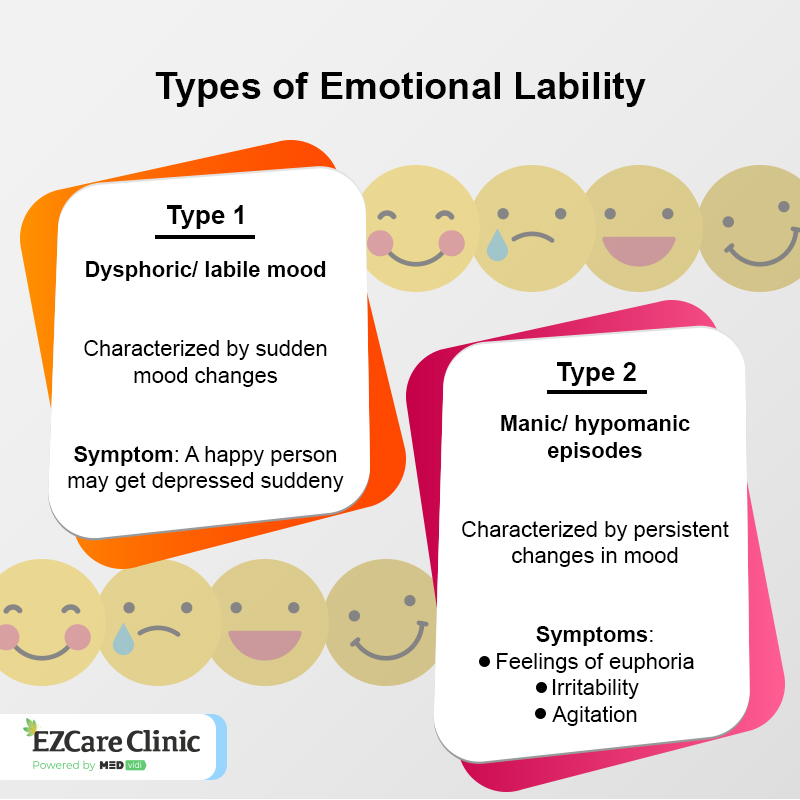
Types of Emotional Lability
Does ADHD Cause Emotional Problems?
People with ADHD experience emotions just like anyone else. However, the intensity with which they experience the emotions is significantly heightened. Sometimes these emotions can last for long and interfere with everyday life.
Over time and with age, most ADHD patients learn to control their emotions. There are, however, instances of ADHD in adults where emotional control is limited.
There are several practical skills and strategies patients with ADHD can employ to improve their emotional coping ability.
A study carried on MS and ALS patient study seeking to identify the
This prompted the American Psychiatric Association (APA) to include
However, emotional dysregulation was removed in subsequent versions of the Diagnostic and Statistical Manual for Mental Disorders.
To date, researchers and mental health experts advocate for its inclusion and regulation. The main argument is emotional dysregulation is evident in adults with ADHD.
How Does ADHD Cause Emotional Dysregulation?
Patients with ADHD often struggle with a set of cognitive skills called executive functions. These mental skills help you keep things in perspective and manage how you respond to certain situations. Impulse control and flexible thinking are examples of these executive functions.
Working memory is another example of executive function that people with ADHD struggle to comprehend.
For instance, when someone with ADHD is preoccupied with how they feel, they may fail to consider other factors and say something harsh without intending to do any harm.
Emotional dysregulation is normally relational. This means it is triggered by personal contact and has control over the affected person, like a partner, friend, or relative.
Consequently, this means the caregiver’s attachment style and ability to cope with the effects of emotional dysregulation largely determine the affected person’s ability to cope with and manage emotions.
An inattentive or abusive caregiver can easily damage a child’s ability to regulate and control their emotional response.
8. What Is the Difference Between Bipolar Disorder and Emotional Lability?
Bipolar disorder is a type of mood disorder. Patients with bipolar disorder are usually unable to prevent bouts of depression and mania.
Even on medication, patients with bipolar disorder can still experience mood swings now and then. As such, it’s important to monitor mood swings, energy levels, and sleeping patterns to identify any changes before they can progress.
What Is Bipolar Disorder?
Also known as manic depression, this mental disorder causes extreme mood swings that include hyper mania or emotional highs.
When you’re sad, you’ll feel hopeless and lose interest and pleasure in most activities. In contrast, during episodes of hyper mania, you’ll experience euphoria, increased energy, activeness, behavior, and the ability to think clearly.
Mood swings and emotional fluctuations in bipolar patients can be triggered by several factors, including:
-
- Concentration
- Sleep patterns
- Self-esteem
- Alcohol and drug use
- Sex drive
Are People With Bipolar Disorder More Emotional?
People who have bipolar disorder are emotional. However, their emotions can turn destructive as it radically shifts from a depressed and sad state to a happy and excited state.
When someone with bipolar disorder is depressed, they’ll know something feels wrong, even if they can’t pinpoint what it is.
During the hyper mania state, the person feels happy, healthy, and productive.
Unfortunately, phases of hyper mania can quickly turn destructive.
For instance, the patient could go on a shopping spree and clear their life savings or get in dangerous activities that could put their lives at risk. A depressive state often follows hyper mania.
A mental health professional gives you the strategies for navigating the symptoms of a mental illness treated.
Emotional Dysregulation in Bipolar Disorder
Emotional dysregulation in patients with bipolar disorder is often marked by:
-
- Emotional hyperresponsiveness
- Poor recognition and acceptance of emotions
- Difficulty in adapting behaviors to experience emotions
During the mixed or manic episodes, bipolar patients exhibit an increased sense of emotional hyperactivity.
During the depressive phase, patients can either display emotional hyper-responsiveness or hypo-responsiveness or blend the two responses.
Emotional regulation can result in various social impairments for patients, including impatience, behavioral dyscontrol when faced with strong emotions, and a low return to the baseline.
9. What Are the Available Treatments and Coping Techniques for Emotional Lability?
The inability to settle down is one of the early telltale signs of uncontrollable emotions.
When emotional lability develops and progresses, it can ruin your relationships and affect your day-to-day activities.
To professionally control emotional lability, a qualified healthcare provider will likely use antidepressant or mood-stabilizing medications.
Additionally, certain therapy, meditative, and psychology techniques can help you learn how to keep your emotions in check.
When treating emotional lability, the main objective is to reduce the frequency and severity of emotional outbursts. If you’re only experiencing mild symptoms that don’t affect your daily life, you likely won’t require medication.
However, if you experience volatile mood swings or show signs of underlying psychiatric conditions, the doctor may use a combination of medication and therapy options.
1. Medication Options for Managing Emotional Lability
Your doctor will guide you on the best medicine to use based on your conditions, possible side effects, and other conditions or medications you’re on.
Some of the most used medications include:
- Dextromethorphan Hydrobromide and Quinidine Sulfate (Nuedexta)
This is by far the only FDA-approved medication recommended to treat emotional lability. A study carried on MS and ALS patients showed a reduction of crying and laughing episodes by half.
- Antidepressants
Antidepressants used to treat emotional lability are typically prescribed in lower doses than when used in treating depression. Drugs like tricyclic antidepressants (TCAs) and selective serotonin reuptake inhibitors (SSRIs) can reduce the severity and frequency of PBA episodes.
2. Therapeutic and Counseling Options
Counseling is one of the most critical interventions for mood liability. A skilled mental health expert walks you through how and why you’re experiencing the condition.
Consequently, you’ll learn that any triggers to emotional lability can be avoided or dealt with. Seeking professional help is a crucial step to managing and overcoming PBA.
Some therapy options that can help you deal with the condition are:
-
- Cognitive-behavioral therapy (CBT)
- Interpersonal therapy
- Problem-solving therapy
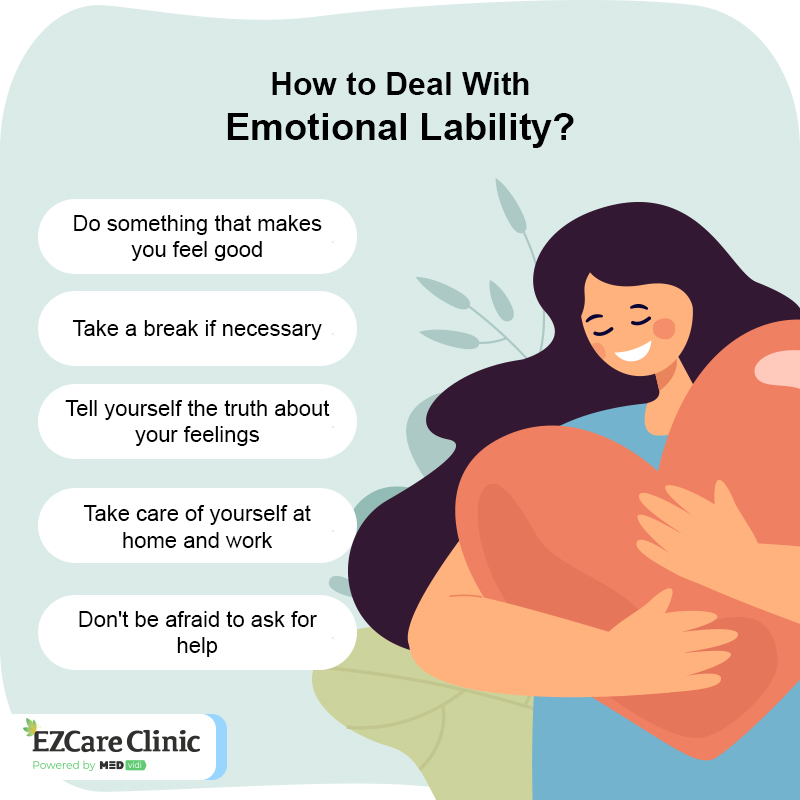
Treating Emotional Lability
3. Coping Techniques
Living with emotional lability can be challenging both to you and your loved ones. Fortunately, several effective coping techniques and mechanisms can ease the severity of the symptoms and help your loved ones understand the condition and what you’re going through.
These coping techniques include:
- Explaining Your Condition to Others
Some mood fluctuations can be embarrassing and uncomfortable. Finding yourself in such a situation can have a negative impact on your self-esteem and confidence.
To avoid this, briefly explain to people close to you to better understand the situation and not react unnaturally when you have an episode.
- Take Small Breaks
Social situations can be draining, making it difficult to control yourself in certain situations. When you’re in public, take small but frequent breaks to focus on yourself.
For example, in any social gathering, you can briefly excuse yourself and take a walk to center yourself.
- Beware of Your Triggers
One of the most effective ways to understand your triggers is through professional counseling sessions. Once you’ve identified the triggers, you can work on avoiding and managing them.
- Develop a Positive Attitude
Overthinking can result in mood swings and emotional episodes. Try and avoid dwelling in the past and instead focus on building a positive mindset and mentality on your current efforts and plans.
- Find a Distraction
Find ways of distracting yourself from emotional lability triggers.
You can use various effective distraction techniques, including:
-
- Closing your eyes
- Breathing deeply
- Counting downwards from a high number
Seek counseling if you are struggling emotionally– Click below to book your appointment with a mental health professional.
Final Takeaway
The underlying reason greatly determines the long-term effects and prognosis for emotional lability patients.
For instance, patients with a history of mental health conditions like borderline personality disorder, bipolar disorder, or persistent brain damage may experience emotional outbursts throughout their lifetimes.
Fortunately, you can figure out triggers that cause emotional lability with guided and professional practice and develop effective techniques to manage emotional outbursts.
If you or someone you know experiences rapid and intense mood changes, especially in out-of-context situations, they may have emotional lability.
Consult with a doctor or therapist for a clear diagnosis and direction.
If you are diagnosed with emotional lability, doctors, therapists, and mental health practitioners can help you develop effective measures to manage your moods and emotions.
Sources
- Pseudobulbar affect: prevalence and management. (2013)
Source link - Nuedexta for the Treatment Of Pseudobulbar Affect. (2013)
Source link - Mood lability and psychopathology in youth. (2009)
Source link
Click the banner below to schedule your appointment with a mental health professional at EZCare Clinic.

